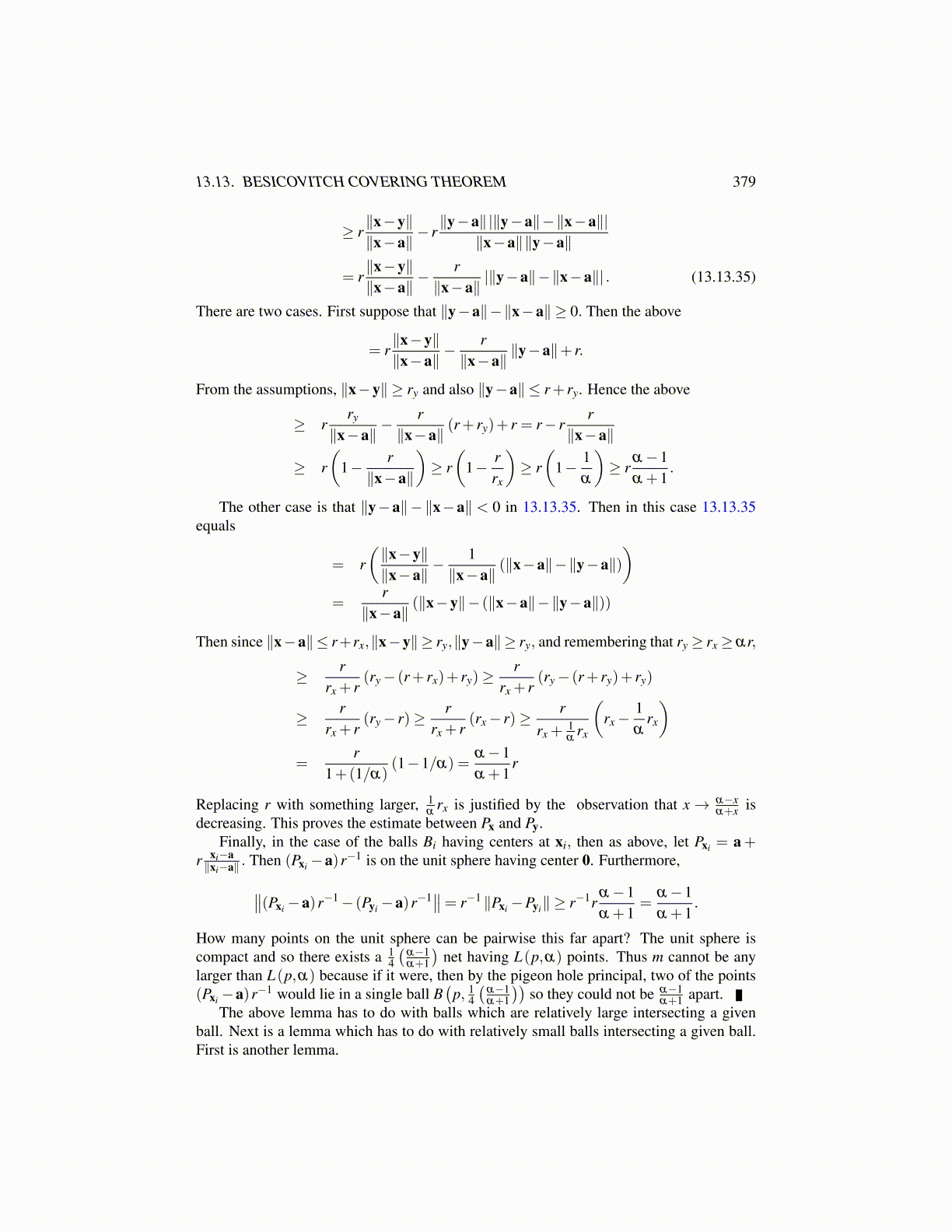
13.13. BESICOVITCH COVERING THEOREM 379
≥ r∥x−y∥∥x−a∥
− r∥y−a∥|∥y−a∥−∥x−a∥|
∥x−a∥∥y−a∥
= r∥x−y∥∥x−a∥
− r∥x−a∥
|∥y−a∥−∥x−a∥| . (13.13.35)
There are two cases. First suppose that ∥y−a∥−∥x−a∥ ≥ 0. Then the above
= r∥x−y∥∥x−a∥
− r∥x−a∥
∥y−a∥+ r.
From the assumptions, ∥x−y∥ ≥ ry and also ∥y−a∥ ≤ r+ ry. Hence the above
≥ rry
∥x−a∥− r∥x−a∥
(r+ ry)+ r = r− rr
∥x−a∥
≥ r(
1− r∥x−a∥
)≥ r(
1− rrx
)≥ r(
1− 1α
)≥ r
α−1α +1
.
The other case is that ∥y−a∥−∥x−a∥ < 0 in 13.13.35. Then in this case 13.13.35equals
= r(∥x−y∥∥x−a∥
− 1∥x−a∥
(∥x−a∥−∥y−a∥))
=r
∥x−a∥(∥x−y∥− (∥x−a∥−∥y−a∥))
Then since ∥x−a∥≤ r+rx,∥x−y∥≥ ry,∥y−a∥≥ ry, and remembering that ry ≥ rx ≥αr,
≥ rrx + r
(ry− (r+ rx)+ ry)≥r
rx + r(ry− (r+ ry)+ ry)
≥ rrx + r
(ry− r)≥ rrx + r
(rx− r)≥ rrx +
1α
rx
(rx−
1α
rx
)=
r1+(1/α)
(1−1/α) =α−1α +1
r
Replacing r with something larger, 1α
rx is justified by the observation that x→ α−xα+x is
decreasing. This proves the estimate between Px and Py.Finally, in the case of the balls Bi having centers at xi, then as above, let Pxi = a+
r xi−a∥xi−a∥ . Then (Pxi −a)r−1 is on the unit sphere having center 0. Furthermore,
∥∥(Pxi −a)r−1− (Pyi −a)r−1∥∥= r−1 ∥Pxi −Pyi∥ ≥ r−1rα−1α +1
=α−1α +1
.
How many points on the unit sphere can be pairwise this far apart? The unit sphere iscompact and so there exists a 1
4
(α−1α+1
)net having L(p,α) points. Thus m cannot be any
larger than L(p,α) because if it were, then by the pigeon hole principal, two of the points(Pxi −a)r−1 would lie in a single ball B
(p, 1
4
(α−1α+1
))so they could not be α−1
α+1 apart.The above lemma has to do with balls which are relatively large intersecting a given
ball. Next is a lemma which has to do with relatively small balls intersecting a given ball.First is another lemma.